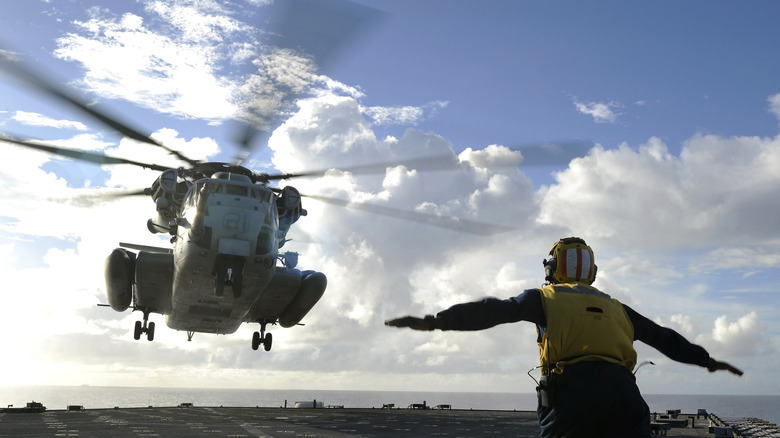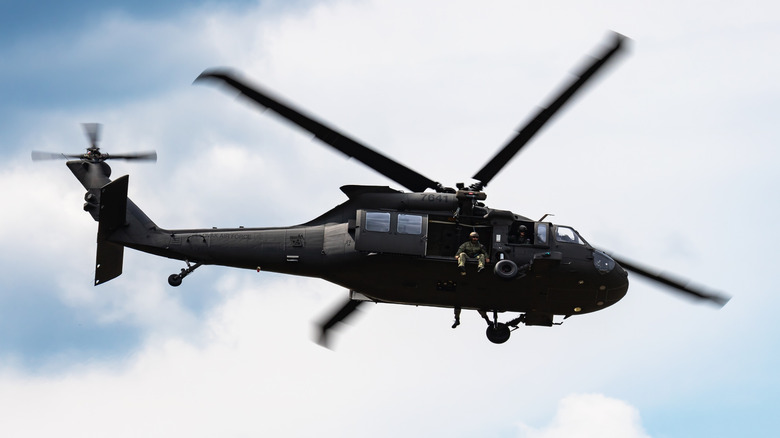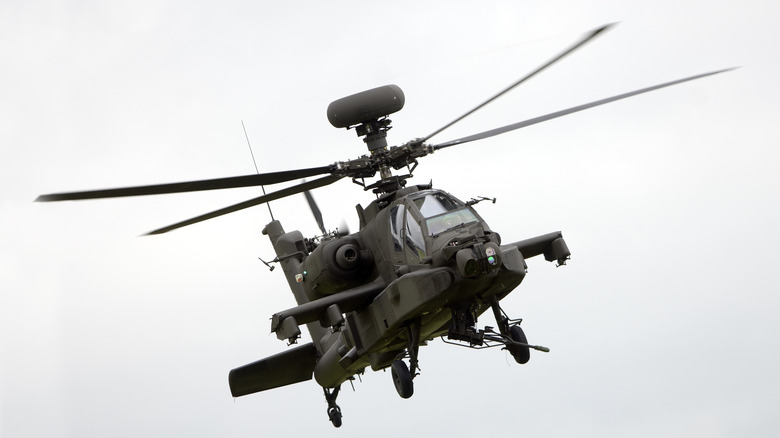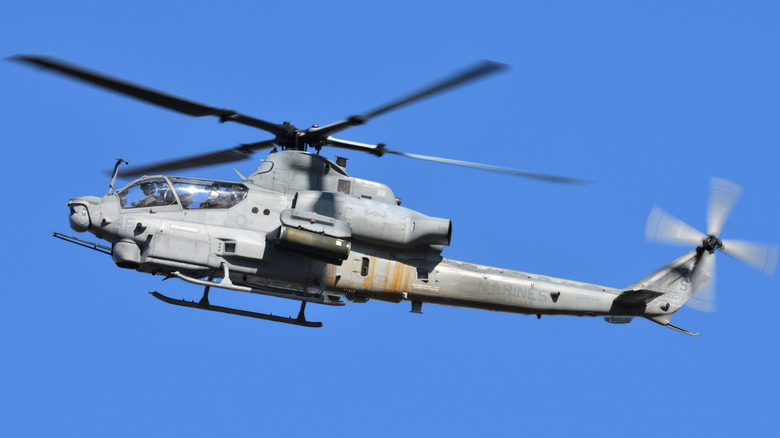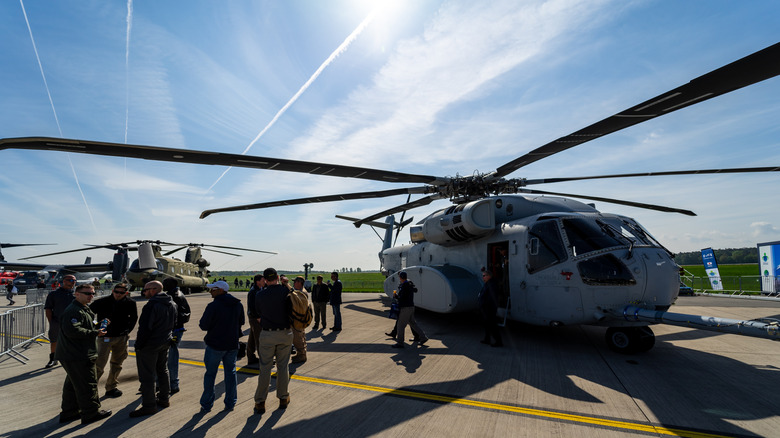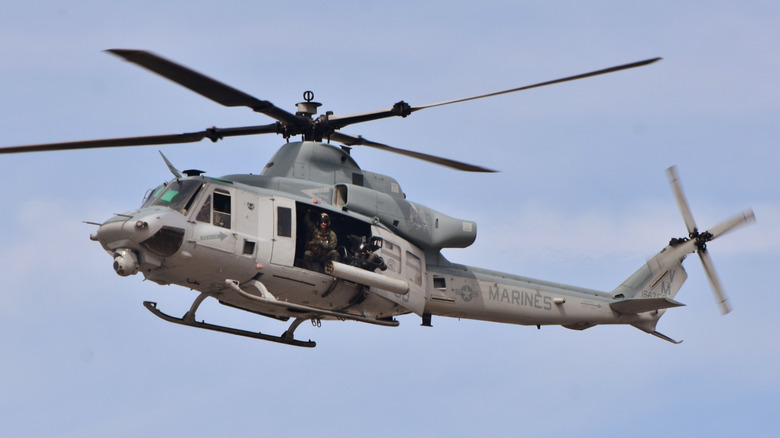How Long Can A Military Helicopter Stay In The Air Without Refueling?
Militaries around the world rely on helicopters for a variety of mission types. They help with expedient troop deployment and getting troops out of areas. Larger helicopters are beneficial when it comes to logistics, transporting supplies and equipment from one location to another, as well as carrying injured troops off the battlefield. There are also attack helicopters that reign havoc on the battlefield, supporting troops on the ground.
Helicopters are the backbone of any competent fighting force. Just as their roles in the field vary, so do their specifications. Some can travel for hundreds of miles before they need to refuel, while others can go indefinitely because they're designed for midair refueling.
A helicopter's flight endurance — how long they can stay in the air without refueling — can be wildly different from one to another. Even upgraded variants of the same chopper can have a different endurance than its predecessor. It's not really possible to pinpoint an exact metric for every military helicopter, as it would be a generalization at best. It's better to look at some of the more widely utilized helicopters in the military to give a rough idea of how long different choppers can stay in the air before refueling.
UH-60 Black Hawk
The UH-60 Black Hawk is one of the most recognizable helicopters employed by the United States Army. It was a pretty significant focus in the '90s as part of the true story behind "Black Hawk Down," and has found itself in headlines recently after one collided with a commercial airliner over Washington D.C. It has survived in the U.S. Army for over 40 years because of its versatility and capabilities. The Black Hawk can be outfitted with external fuel tanks that can hold up to 450 gallons of fuel, increasing its flight time, but it has a normal mission endurance of about four hours.
The Black Hawk finds itself taking on battlefield medical evacuations, search and rescue operations, transporting troops and equipment, and special operations. It's not just the U.S. Army that uses the Black Hawk as a workhorse, too. It's such a capable aircraft that multiple military branches have their own variant of the Black Hawk, as well as various civilian services. The Los Angeles County fire department utilizes a variant of the Black Hawk — the Firehawk — that comes equipped with a 1,000 gallon tank for water.
Getting fires under control requires multiple passes for dumping water, a task that's easier to accomplish when the helicopter doesn't have to return to base multiple times to refuel. Border Patrol has them, and even the heads of state for at least 11 different nations use a variant of the Black Hawk.
AH-64 Apache
The Apache is an impressive weapon of war that every soldier is happy to have on their side. The 30mm M230 Chain Gun, which carries 1,200 rounds and fires as many as 650 rounds per minute, can provide plenty of air support on its own — causing effective damage on soft targets as well as hard.
This attack chopper has no problem taking out most other targets like main battle tanks with any other weapons it's loaded out with; such as Hydra 70mm and CRV7 70mm air-to-ground rockets, AGM-114 Hellfire missiles, or its AIM-92 Stinger. It's four-blade main rotor and a four-blade tail rotor are powered by two T700-GE-701C turboshaft engines that can get it up to 279 kph (approximately 173 mph).
Its 300 mile maximum range is great for an attack helicopter, but what's more helpful on the battlefield is its ability to stay in the air for two and a half consecutive hours. This is especially helpful for supporting ground troops or taking on a reconnaissance mission where it might have to hover for an extended period of time.
AH-1Z Viper
The U.S. Army takes full advantage of the Apache, but the U.S. Marine Corps leverages the capabilities of the AH-1Z Viper on the battlefield. Comparing the two attack helicopters to determine which is the ultimate attack helicopter only adds more competition between the branches. They're both phenomenal pieces of machinery in their own right, but when it comes to flight endurance, the Viper takes the win.
Viper aircraft can stay in the air without refueling for three hours and 30 minutes, plus a 20 minute fuel reserve. The Viper looks similar to the Super Cobra it replaced but instead of a two-bladed rotor system, it has a four-bladed composite rotor system powered by two General Electric T700-GE-401C turboshaft engines.
With a capacity for roughly 412 gallons of fuel, the Viper has a combat radius of 131 nautical miles, but a maximum range of 310 nautical miles. It can support a variety of weapons with its six wing stores, including hellfire missiles, 70mm rockets, and a 20mm gun. The Marine Corps operates the Viper in conjunction with the UH-1Y Venom, a utility chopper that has 85% commonality with the Viper, including a similar flight endurance.
The new CH-53K King Stallion
The Sikorsky CH-53K King Stallion is the most recent CH-53 variant, replacing the CH-53E for the Marine Corps. It's a heavy lift helicopter capable of carrying 27,000 pounds in a 110 nautical mile mission radius — three times the ability of the CH-53E. On top of that, it can carry 36,000 pounds externally.
The USMC plans to procure 200 of the new King Stallion, with its first deployment coming in 2025. It's three T408-GE-400 turboshaft engines, each pushing out 7,332 shaft horsepower, are a big reason for its ability to lift so much weight. Now, the new variant is capable of refueling mid-flight, but it can go roughly four and a half hours before it burns up the entirety of its 2,225 gallons of fuel.
That's a good amount of time for a utility chopper to transport as many as 30 troops at their destination. If the crashworthy seats are removed from the new King Stallion's cabin, it's wide enough to hold two 10,000-pound 463L pallets, a High-Mobility Multipurpose Wheeled Vehicle (a Humvee), or a combination of both. It's a big leap forward from the CH-53E that had been in service since 1981.
UH-1Y Venom
Bell's UH-1Y Venom is an upgraded version of the Vietnam-era UH-1 Iroquis — commonly referred to as a Huey — utility helicopter. The new version comes with infrared sensors and compatibility with the Optimized TopOwl helmet that seamlessly switches between night vision and normal.
Unlike the Viper, it only carries 388 gallons of fuel, but the difference between the two in endurance isn't too different. The UH-1Y Venom can stay in the air for a little over three hours, which is significantly better than older models that only had an endurance of around two hours.
The Venom has two General Electric T-700-GE-401C turboshaft engines that produce 1,800 shaft horsepower. This updated variant also has a rotor system with four ballistically-tolerant blades, rather than two. The improved capabilities of this helicopter allows it to accomplish a variety of missions before even landing. It can drop off troops at their landing zone, airlift pallets of supplies and equipment, and provide aerial reconnaissance before returning to base. Moreover, the Venom can be fitted with a series of weaponry to accomplish attack missions and give support to the troops on the ground.
